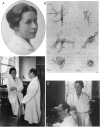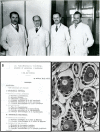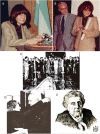Women Neuroscientist Disciples of Pío del Río-Hortega: the Cajal School Spreads in Europe and South America
- PMID: 34040507
- PMCID: PMC8143187
- DOI: 10.3389/fnana.2021.666938
Women Neuroscientist Disciples of Pío del Río-Hortega: the Cajal School Spreads in Europe and South America
Abstract
Pio del Rio-Hortega was not only the discoverer of the microglia and oligodendroglia but also possibly the most prolific mentor of all Santiago Ramon y Cajal's disciples (Nobel awardee in Physiology or Medicine 1906 and considered as the father of modern Neuroscience). Among Río-Hortega's mentees, three exceptional women are frequently forgotten, chronologically: Pio's niece Asunción Amo del Río who worked with Río-Hortega at Madrid, Paris, and Oxford; the distinguished British neuropathologist Dorothy Russell who also worked with Don Pío at Oxford; and Amanda Pellegrino de Iraldi, the last mentee in his career. Our present work analyzes the figures of these three women who were in contact and collaborated with Don Pío del Río-Hortega, describing the influences received and the impact on their careers and the History of Neuroscience. The present work completes the contribution of women neuroscientists who worked with Cajal and his main disciples of the Spanish Neurological School both in Spain (previous work) and in other countries (present work).
Keywords: Amanda Pellegrino de Iraldi; Dorothy Russell; Spanish Neurological School; female neuroscientists; history of neuroscience; microglia; oligodendrocyte; pioneer female scientists.
Copyright © 2021 Nombela, Fernández-Egea, Giné, Worbe, del Río-Hortega Bereciartu and de Castro.
Conflict of interest statement
The authors declare that the research was conducted in the absence of any commercial or financial relationships that could be construed as a potential conflict of interest.
Figures






Similar articles
-
Pío del Río-Hortega: The Revolution of Glia.Anat Rec (Hoboken). 2020 May;303(5):1232-1241. doi: 10.1002/ar.24266. Epub 2019 Oct 18. Anat Rec (Hoboken). 2020. PMID: 31525279
-
Wilder Penfield, Pío del Río-Hortega, and the discovery of oligodendroglia.Neurosurgery. 2007 May;60(5):940-8; discussion 940-8. doi: 10.1227/01.NEU.0000255448.97730.34. Neurosurgery. 2007. PMID: 17460531
-
Cajal and the Spanish Neurological School: Neuroscience Would Have Been a Different Story Without Them.Front Cell Neurosci. 2019 May 24;13:187. doi: 10.3389/fncel.2019.00187. eCollection 2019. Front Cell Neurosci. 2019. PMID: 31178695 Free PMC article. Review.
-
Pío del Río Hortega and the discovery of the oligodendrocytes.Front Neuroanat. 2015 Jul 7;9:92. doi: 10.3389/fnana.2015.00092. eCollection 2015. Front Neuroanat. 2015. PMID: 26217196 Free PMC article. Review.
-
The Women Neuroscientists in the Cajal School.Front Neuroanat. 2019 Jul 16;13:72. doi: 10.3389/fnana.2019.00072. eCollection 2019. Front Neuroanat. 2019. PMID: 31379519 Free PMC article.
References
-
- Allen I. V. (2006). “The changing face of neuropathology,” in Understanding Disease: a Centenary Celebration of the Pathological Society, eds Hall P., Wright N. A. (Chichester: John Wiley and Sons; ), 185–191.
-
- Bunge M. (2016). Between Two Worlds: Memoirs of a Philosopher-Scientist. Berlin: Springer.
LinkOut - more resources
Full Text Sources
Other Literature Sources

